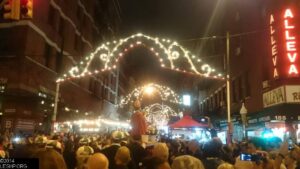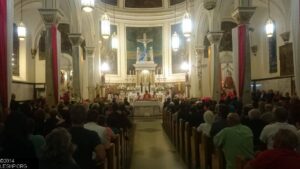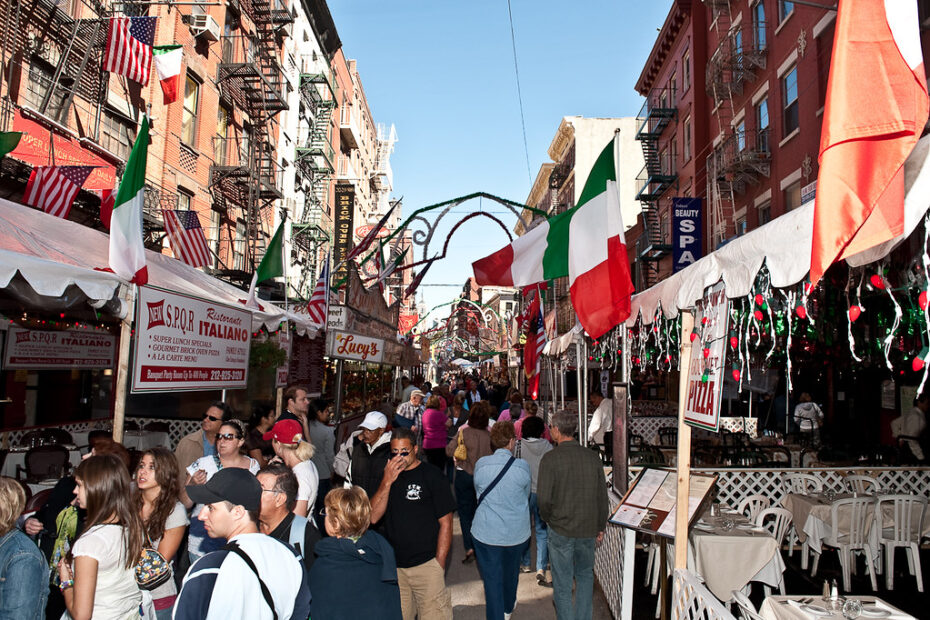Summary
The Feast of San Gennaro has been a beloved tradition in New York City's Little Italy for nearly a century. This annual event invites visitors to experience the rich heritage, mouthwatering cuisine, and lively atmosphere that have come to define our historic neighborhood.
Everybody loves the Feast of San Gennaro, but for different reasons. I’ve seen many newscasts this week claiming, “The food is the centerpiece of the festival!” Well, not for everyone. Traditional Italian Americans would say that the mass and procession are the true centerpiece. I’d wager that 90% of festival-goers aren’t even aware of the importance of what is one of the last authentic cultural experiences left in New York City.
Key Takeaways
- San Gennaro (St. Januarius), is the martyred saint of Naples, Italy, and Neapolitans have been worshiping the saint for over 1500 years.
- Early Italian immigrants were shunned by existing Catholic establishments in NYC, so they built their own churches based on which saints they honored in provinces and townships they came from in Italy.
- Church of Most Precious Blood was opened in 1904, gifted a relic of St. Januarius, and became the National Shrine Church of San Gennaro
- In 1926, a group of parishioners laid the foundation of the feast with a one day ceremony.
- The festival has since grown to become one of the largest festivals in America, and one of the most important ceremonies for Italian-Americans of all backgrounds.
What is the Feast of San Gennaro?

The Feast of San Gennaro has been a beloved tradition in New York City’s Little Italy for nearly a century. This annual event invites visitors to experience the rich heritage, mouthwatering cuisine, and lively atmosphere that define our historic neighborhood. The feast has grown from its humble beginnings as a small religious observance to become one of the city’s largest and most anticipated street festivals.
More than just a food and music extravaganza, the Feast of San Gennaro holds profound significance for Italian Americans and plays a crucial role in preserving cultural identity. It honors Saint Januarius, the patron saint of Naples, while also serving as a testament to the resilience and contributions of Italian immigrants who faced discrimination upon arriving in America. As visitors stroll through the festive streets, they witness a living celebration of Italian-American pride, tradition, and community spirit, all of which have become integral to New York City’s diverse cultural tapestry.
Italian Festivals of New York City
Italy is a relatively young country. Before the unification of Italy in 1861, the Italian peninsula and surrounding islands were divided by several governments and languages. After 1861, a new nation was formed, and all regions were required to adopt an entirely new way of life. It wasn’t until Italians began immigrating to America in the late 19th century that they were brought together in a small district in Lower Manhattan (as well as other places), united only by the flag of their newly founded nation.
Italian immigrants brought with them a strong Catholic faith and a desire for churches where they could worship in their native language. Many Italian neighborhoods developed around these churches, which provided not only religious services but also social services, language classes, and community support.
At first, Italians from different regions did not necessarily blend together, so micro-districts were formed. For example, people from Sicily settled along Elizabeth Street, while people from Naples settled along Mulberry Street. Immigrants from various regions established their own churches based on the saints venerated in their homeland.
The Religious Roots of the Feast of San Gennaro
San Gennaro’s Role as Patron Saint of Naples
The Feast of San Gennaro has deep religious roots that trace back over 1,500 years. San Gennaro, also known as Saint Januarius, was the Bishop of Benevento who met a martyr’s fate in 304 AD during the persecution of Christians under Emperor Diocletian. His significance to the city of Naples grew over time, eventually leading to his designation as the city’s principal patron saint in 472 AD.
San Gennaro’s patronage is closely tied to a miraculous event that occurred during a powerful eruption of Mount Vesuvius. As the volcano threatened to destroy Naples, much like it had destroyed Pompeii four centuries earlier, thousands of Neapolitans sought refuge in the catacombs where San Gennaro was entombed. They fervently prayed to the saint for protection, and their prayers were answered as the city was spared from destruction.
The Importance of Saint Veneration in Italian Culture
Saint veneration holds a central place in Italian Catholic culture, particularly in Naples. The intensity of devotion to Catholic saints is a defining characteristic of religious practice in Italy. Images of saints are ubiquitous in public spaces, often outnumbering depictions of Christ himself. These saints serve as patrons of cities, towns, and regions, reflecting the enduring ideal of patron-client relationships in Italian society.
In this context, the veneration of San Gennaro exemplifies the reciprocal nature of saint worship in Italian culture. Devotees ask for favors and protection, and in return, they are expected to venerate the saint and cultivate his following. This relationship is seen as mutually beneficial, with the saint acting as a powerful intermediary who has a direct line to divine power.
The Church of the Most Precious Blood

Italian immigrants in New York City initially faced exclusion from established Irish Catholic churches. Many were forced to worship in makeshift spaces, including the basement of Transfiguration Church on Mott Street. Recognizing the unique needs of this growing community, the Vatican decreed the formation of an Italian National Parish in 1888, under the care of the Scalabrini Fathers of the St. Charles Borromeo Society. By 1891, the Scalabrini Fathers had purchased land at 113 Baxter Street, and construction of the Lower Church began.
Building the church proved to be a monumental task. With the parish facing significant debt, the Archdiocese of New York enlisted the help of the Franciscan Order in 1894. After years of effort, the cornerstone for the Upper Church was laid on July 7, 1901, and the structure was completed by 1904. The Franciscans provided the church with a relic of San Gennaro’s blood, symbolizing the strong connection between their homeland and their new life in America. This church became the National Shrine Church of San Gennaro.
This is why the church and the feast are so important to many Italian Americans.
Religious Processions and Ceremonies

In Italy, the Feast of San Gennaro (Festa di San Gennaro) features several important religious ceremonies that highlight the deep spiritual significance of the event. A solemn high Mass celebrating the patron saint of Naples takes place at the Shrine Church of the Most Precious Blood. This Mass is followed by a religious procession where the statue of San Gennaro is carried through the streets, allowing devotees to pay homage to their protector.
The most anticipated event during the feast is the “Miracle of San Gennaro.” This phenomenon involves the liquefaction of the saint’s preserved blood, which is kept in a vial at the Cathedral of Naples. The miracle typically occurs on September 19th, the anniversary of San Gennaro’s martyrdom. Many believers view the occurrence of this miracle as a good omen for the city, while its failure to materialize is often seen as a sign of impending calamity.
Cultural Significance for Italian Americans
Preserving Italian Heritage in the New World
The Feast of San Gennaro holds immense cultural significance for Neapolitan Americans, serving as a powerful link to their ancestral roots. It started as a modest one-day block party to honor San Gennaro and has evolved into a world-renowned 11-day event that spans several blocks of the Little Italy neighborhood.

The feast’s origins reflect the immigrants’ desire to maintain their Italian traditions in their new home. By celebrating their patron saint, they created a tangible connection to their heritage, preserving and sharing their cultural identity in the New World. This act of cultural preservation has become a cornerstone of the Italian-American experience in New York City. As Italian Americans with ancestry from all across Italy blended after a few generations in America, the feast has become a symbol of pride not just for Neapolitans but for people from all Italian backgrounds.
This sense of community has evolved to extend beyond those of Italian descent. The feast has become a symbol of the broader cultural mosaic that defines New York City, bringing together people from various backgrounds to celebrate a shared sense of community. It offers an opportunity for Italian Americans to showcase their culture and traditions to a wider audience, fostering understanding and appreciation among different ethnic groups. What was once an entirely Italian ethnic experience has now become a celebration of foods from all corners of the globe.
Conclusion
The Feast of San Gennaro has grown from a modest religious observance into a vibrant celebration of Italian-American culture, reflecting the resilience and pride of a community that faced discrimination upon arriving in America. It has played a crucial role in preserving cultural identity, passing down traditions, and fostering a sense of belonging among Italian Americans. The feast’s evolution mirrors the journey of Italian immigrants, transforming from a small neighborhood gathering to a citywide event that showcases the rich tapestry of Italian heritage.
Beyond its cultural significance, the Feast of San Gennaro has become a beloved New York City institution, drawing visitors from all backgrounds to experience the warmth and vibrancy of Little Italy. It has a significant impact on the local economy, tourism, and the city’s multicultural fabric, serving as a model for other ethnic celebrations across the country. As the feast continues to evolve, it remains a powerful testament to the enduring spirit of community and the importance of honoring one’s roots in the ever-changing landscape of American society.
So, please come and enjoy your sausage and peppers, but be aware of the reason why we gather here each September.
Please visit:
https://sangennaronyc.org/
https://oldcathedral.org/shrine-church-of-the-most-precious-blood
Our photos from the 2014 mass and procession:
https://www.facebook.com/share/p/uUE16pdXqvcSZiTX/

Eric is a 4th generation Lower East Sider, professional NYC history author, movie & TV consultant, and founder of Lower East Side History Project.

I was born and raised in Little Italy. My father was born in Italy, came to America when he was 9 years old and was honored and proud to call AMERICA his new home. I still live in the apartment me and my two brothers were raised in and now, many years later, I am honored and privileged to say I am a board member of the Figli di San Gennaro (Children of San Gennaro). Regarding the wonderful factual article I just read, all I want to say to Mr. Ferrara is “THANK YOU!”. I loved the article!
Thank you for the kind words and sharing your story… And you are doing a great job with the feast!
I live in Little Italy now and my family came from Italy to this neighborhood over a hundred years ago. The feast establishes the boundaries of the little Italy historic district which is Canal St to Bleeker St. and Lafayette st to the Bowery. There is no such area called NOLITA only is the mind of the real estate developers.
Have you heard of the new thing they were recently trying to push? “LiCHi”? (“Little Italy/Chinatown.” haha.)
Yeah, it is always a real estate ploy to re-brand a neighborhood. Same goes for East Village, NoHo, etc. That’s life 🙂